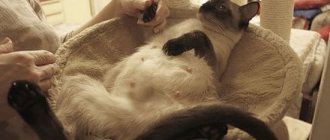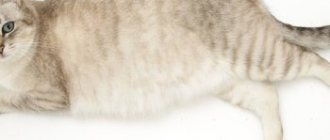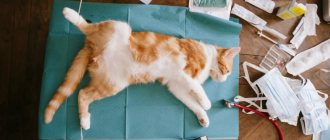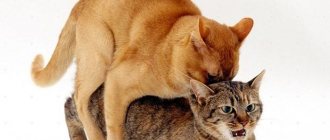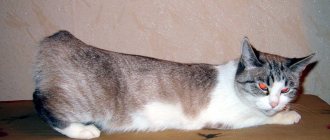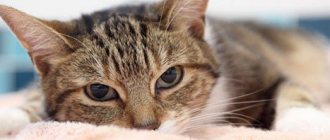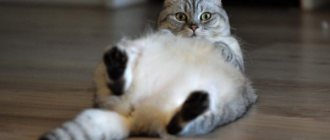Cat pregnancy
Normally, pregnancy in most breeds lasts 63 days, but deviations up or down by 3 days are possible, and this is not a pathology. A month after the start of conception, when stroking the belly, you can already feel the kittens. But it is impossible to determine the quantity in this way, since they are very small - barely reaching 3 cm in length.
Gradually, the cat's belly begins to grow. From the 5th week, it is not recommended to probe the abdominal wall of your pet for a long time and often, as this can harm the normal course of pregnancy.
If the owner is impatient to find out about the number of future offspring and its condition, an ultrasound can be performed at a veterinary clinic.
From the 6th week of pregnancy there is a significant increase in the size of the expectant mother’s belly, and after another 7 days, when you put your hand on it, you can feel the kittens actively moving in the womb.
In the last week, it is already difficult for the cat to move, she rests a lot and begins to look for a secluded place where she will give birth. Therefore, it is worth preparing in advance for this process, which can begin any day. You need to find and put a large box in a secluded place so that the pet can safely give birth to babies and live with them there for some time.
We recommend an article about the duration of a cat's pregnancy.
Possible problems
During pregnancy, a cat may experience health problems caused by genetic disorders, infectious diseases or external causes. In this case, the life and health of the pet depends on how quickly the owner contacts the veterinarian.
Premature birth
If labor begins earlier than 56 days after mating, it is considered premature. Premature kittens aged 50–55 days can still be released, but with those born even earlier there is very little chance of success.
If your cat goes into premature labor, you need to take her to a veterinary clinic as quickly as possible.
The main causes of premature birth are:
- developmental disorders in kittens;
- infectious diseases (mycoplasmosis and others);
- injuries and falls;
- severe stress;
- problems with the placenta.
Signs of the onset of premature labor:
- cat anxiety;
- vaginal discharge;
- heat;
- contractions.
It is necessary to take the cat to the doctor as quickly as possible, because he may have time to relieve the tone of the uterus with the help of special medications and give the pet a chance to bear kittens. If it is already too late, then the doctor has more opportunities to ensure the animal a successful outcome of premature birth.
Post-term pregnancy
If the kittens are not born before day 70, the pregnancy is considered post-term. Sometimes cubs born on days 70–75 turned out to be quite healthy, but this is rather an exception to the rule. Most often, failure to give birth on time means that the kittens died in the uterus from hypoxia. Then, to save the cat, the doctor performs a caesarean section or removes the entire uterus. The causes of post-term pregnancy can be:
- a large number of fruits;
- fruits are too large;
- body features of the animal (narrow pelvis);
- hormonal disorders.
Most often, the problem of post-term pregnancy is solved by caesarean section in a veterinary clinic.
Uterine bleeding or miscarriage
Sometimes after an injury, a cat will begin to bleed from the vagina. It is the cause or sign of an incipient miscarriage. It is important to consult a doctor as soon as possible, then the pregnancy may be able to be saved. Miscarriage is often caused by uterine torsion. This is the name for bending or twisting of the long horns of an organ that occurs due to injury. This leads to intrauterine death of kittens and removal of the uterus.
In case of miscarriage and uterine bleeding, only a veterinarian can help
In addition to uterine torsion, the causes of miscarriage may be:
- family ties between parents;
- breed characteristics;
- age of the cat;
- parasite infection;
- poisoning;
- obesity.
Signs of miscarriage:
- any vaginal discharge (except clear white in late pregnancy or bloody a day or two before birth), especially if it has an unpleasant odor;
- fever;
- weight loss and appetite;
- vomit;
- weakness;
- abdominal asymmetry;
- anxious cat behavior.
Ectopic pregnancy
A pathology in which the fetus develops outside the uterus is called an ectopic pregnancy. It can be primary (the fetus is attached outside the uterus from the very beginning) and secondary (the fetus leaves the uterus as a result of its rupture due to injury or pathology of the reproductive organs). In both cases, normal development of the embryo is impossible, it is doomed to death, and if it is not removed in a timely manner, the cat will also die. After all, as a result of an ectopic pregnancy, she develops sepsis, tissue necrosis or damage to internal organs. The most favorable outcome is when the embryo is removed from the cat’s body on its own, in the form of a miscarriage.
If any signs of pathological development of pregnancy appear, you should immediately contact a specialist.
An ectopic pregnancy is life-threatening for a cat; in such a situation, it is necessary to remove the embryo from the abdominal cavity as quickly as possible
Parallel pregnancy (superfecundation and superfetation)
In cats, there is such an interesting phenomenon as parallel pregnancy.
Superfecundation is the simultaneous fertilization of a cat's eggs with sperm from different cats. This happens when a cat mates with several males during one ovulation period. As a result, the eggs receive different genetic material, and the kittens of the same litter may be completely different and have different fathers. In principle, this option is not dangerous for the cat and is no different from standard pregnancy.
When a cat has superfecundation, in one litter there are kittens from different fathers that are completely different from each other
Superfetation is the simultaneous gestation of two litters of kittens at different stages of maturation. This can happen if an already pregnant female copulates with a male again (usually at 3 weeks from mating), resulting in a second, younger litter of cubs appearing in the womb. Thus, the two groups of kittens develop several weeks apart. This situation rarely ends well. Often during the birth of an early litter, the later one dies, as the uterus pushes out the premature younger kittens. It happens less often that the early litter is successfully born, while the later one remains in the uterus and develops normally there for several more weeks, after which a second birth follows.
In case of superfetation, you need to take the cat to the veterinary clinic for birth, this will increase the chances of survival of kittens of the younger litter
With superfetation, problems may arise due to the mother's insufficient teats for all kittens or insufficient milk supply. But these difficulties can be solved by the cat owner by taking upon himself the responsibility of feeding some of the babies.
Sometimes an owner has to literally feed his pet's kittens
Infertility and multiple pregnancy: what affects fertility
There are many theories why cats give birth to different numbers of kittens and what this depends on. Among the most widespread are:
- Influence of nutrition. If there is insufficient or poor quality food, the cat's chances of becoming pregnant are reduced. Nature seems to protect dead and weak kittens from being born. This is called nutritional infertility.
- Obesity. At the same time, many animals stop estrus, which indicates serious hormonal changes in the body. And in this condition, pregnancy cannot occur at all.
- Comfortable living conditions: cleanliness, comfort, favorable emotional climate, absence of stressful situations and other factors.
- Heredity. If the cat's mother gave birth to a small number of kittens, then you should not expect multiple pregnancies from your pet.
- Diseases of the reproductive system that affect the ability to conceive. For example, endometritis, pyometra and others.
- Temperament of a cat. Ovulation in cats occurs under the influence of the active behavior of the male during intercourse. Accordingly, the more active the partner is, the more eggs will be released and their fertilization will occur. If the cat is phlegmatic, there will be fewer kittens.
- Just like people, pets can be incompatible with each other. Therefore, if there is no pregnancy from a particular partner, you can try to change him.
- The quality of a cat's sperm also plays an important role. With prolonged abstinence or frequent sexual intercourse, it decreases sharply. It also depends on the living conditions of the animal, the psychological climate, healthy food, the general condition of the body, the absence of chronic diseases, etc.
- Hormonal imbalance in a cat, in which little follicle stimulating hormone (FSH) is released, which leads to the release of a small number of eggs. This, in turn, also applies to low-fertility pregnancies.
- Weight, age and general condition of the expectant mother’s body. Older cats give birth to fewer kittens.
- Pedigree and barn cats have different fertility rates. The latter most often give birth to many kittens, and this trend does not change with the age of the pet. Animals with blue blood have a tendency to have low-fertility pregnancies.
- Some breeders believe that the number of offspring is related to the number of matings. After the first time, one or two kittens are born, by 7 - the maximum possible for a given individual, and then their number decreases again.
- Another opinion is that the faster intercourse occurs from the beginning of estrus, the greater the number of new pets will be born.
All these theories have both confirmation and refutation. For example, if you adhere to the opinion that nutrition and stress affect pregnancy, it turns out that yard cats that do not have owners should not give birth at all, but they bring the maximum number of pets and calmly bear and raise them in the future. At the same time, females who are in calm home conditions with sufficient nutrition and care cannot always please their owners with kittens.
Also read about discharge from a pregnant cat.
Fertility rate in cats
Felinologists have developed a large number of new breeds of cats, and often, for the sake of one trait, others were abandoned. Pedigree pets rarely give birth to more than 5 kittens, and yard representatives can give birth to 15 cubs. Accordingly, the more pets are born, the greater the likelihood that one of them will continue the family line.
For an approximate calculation of future offspring, professionals recommend paying attention to the number of nipples the expectant mother has. Subtract two from their number and get the approximate number of kittens that should appear. There can be from 6 to 11 mammary glands, but most often there are 8. This method is approximate and often does not work.
What age is most favorable for offspring?
A pet can become pregnant for the first time at the age of 6 months, she has her first estrus, and is ready to reproduce. But veterinarians advise not to allow mating at this time, because she is not psychologically ready to become a mother; in fact, she is still a teenager. Early birth can bring health complications; kittens are usually weak, painful, and sometimes incapable of life. Experienced cat breeders recommend waiting for the second or even third heat.
Features of pregnancy and childbirth in different breeds
Felinologists have noted a certain tendency during pregnancy in different breeds of cats:
- Representatives of cats with long hair reach maturity later than their short-haired counterparts, and their pregnancy lasts longer.
- Scottish Folds and British Folds give birth to fairly large kittens and often require veterinary care. And also the gestation period for their kittens is longer - up to 72 days, which leads to an increase in the size of the future offspring.
- With frequent pregnancies, the cat's body quickly depletes. This is a very important factor to consider when breeding animals.
- The duration of multiple pregnancies is most often reduced. Since this triggers natural protective mechanisms that prevent excessive exhaustion of the mother. The size of the kittens will also be slightly smaller compared to their counterparts born from a normal pregnancy. But this is compensated for, and they catch up with their peers in weight and development very quickly.
- Cats older than 7 years often give birth to pets with congenital anomalies or weakened ones. Therefore, upon reaching this age, it is recommended to stop mating. Such signs indicate the weakened health of the mother herself, which means there is no need to undermine it even more.
How many kittens can a cat give birth to?
Another logical question from owners: how many kittens can a cat give birth to at one time (the first time or the maximum number)?
As a rule, for the first time a cat can give birth to 1 – 3 kittens, since the cat’s reproductive system is not fully formed. Older cats also give birth to a small number of kittens - their reproductive function fades.
How many kittens can a cat in her prime give birth to at one time? Typically up to 6 kittens. After all, nature has endowed a cat with only 8 nipples, which means that it is difficult for a cat to feed more than 8 kittens.
However, there are exceptions. No one knows exactly how many kittens a cat can give birth to, but there have been recorded cases of the birth of 12 kittens.
Planning a cat's pregnancy
Pregnancy is a complex process and its planning, including in cats, is a very important stage. But the opinions of experts and ordinary owners on this issue differed:
- Often breeders or felinologists plan pregnancies in their cats no more than once a year. At the same time, they carefully monitor the pet’s health and take a responsible approach to choosing a cat. There is an opinion that with such frequency the female will feel great, which will affect the high quality of the offspring.
- Veterinarians have a different opinion. They believe that if each heat ends in the birth of kittens, this does not negatively affect the health of the cat or offspring. Therefore, pregnancy 3-4 times a year is the norm. Otherwise, if an animal is denied sexual activity, health and mental problems will arise.
- Owners with extensive experience think differently - two lambings every 12 months are enough to maintain the physical tone and well-being of the female, which also will not affect the health of the offspring. With more rare intercourse, the animal begins to suffer both morally and physically.
Caring for a future mother cat
If in dogs the nutritional needs during pregnancy change only by the second month, then in cats it changes immediately. They need more calories, nutrients, vitamins. Having noticed the first signs, it is advisable to increase the portion. The specific food is high in calories and contains a sufficient amount of fatty acids due to Omega-3 (they are required for the normal development of embryos). Biologically appropriate food SUPERPET is ideal for pregnant and lactating cats. During this period, you need to increase the daily norm by 100%.
Still, with a pregnant female you need to visit a specialist at least once. You should tell him about your diet, as well as the medications you give to your pet (for example, against parasites). Some of them lead to fetal malformations. Vaccination during this period is not the best idea, so vaccinations should be considered in advance.
While carrying kittens, the female should be calm and not stressed. If there are children in the house, you need to explain to them why you can’t cuddle your pet or play active games with her. Caring for a pregnant cat should not be too intrusive - the animal must be handled with extreme caution. Exhibitions, travel, and flights will clearly not benefit the tailed one.
You can’t squeeze a cat in a position; a miscarriage may occur.
How to help a cat during its first birth
Usually a cat instinctively knows how and what to do during childbirth, but for the first time it may get scared and hide in an inaccessible place, for example, under the bed. Therefore, it is important for the owner to prepare in advance for such an important process.
How to prepare a place for childbirth
When giving preference to a place for childbirth, you need to adhere to some rules:
- Availability. Having made a box with bedding for a future woman in labor, it is important to make sure that she does not have to jump into it. You can cut out the door or remove part of the wall, then both the cat and the owner will have greater access inside.
- Capacity. It must be remembered that the pet, along with the born kittens, will be there not for one day, but for up to 2 months, so there should be enough space for both the mother and the growing offspring.
- Silence. Select a place in an apartment or house where it will be as quiet and peaceful as possible; this could be a secluded corner or the space between the sofa and the wall. Otherwise, the cat will start to worry and hide, for example, in a closet. This behavior indicates that she does not feel protected in the designated area and you need to think about moving her to a quieter place.
- Convenience. It is worth putting a layer of clean old cloth or gauze at the bottom of the box; you can buy special absorbent sheets at the pharmacy. This will create additional comfort for the woman in labor.
Maternal care
As a rule, there are no special recommendations for caring for healthy, newly born kittens with a mother present. The programs of maternal instincts in cats are laid down at the highest level, so it is better to take care of a pet who has devoted a lot of effort to the complex birth process.
Once a cat begins to feed its cubs with milk, it needs good nutrition, rich in proteins, vitamins and beneficial microelements. If there is an acute issue about the distribution of offspring, babies can be taught to eat independently from the age of three weeks.
Harbingers of childbirth
A few days before the start of the long-awaited event, many owners note a change in their pet’s behavior:
- 2-3 days before birth, the external genitalia swell slightly and turn pink. The cat begins to carefully lick its belly and wash itself.
- Decreased activity - becomes detached, apathetic.
- Lack of appetite. Often within a day or so, most cats will refuse to eat. There is no need to insist, they themselves know how it will be better for them. But you need to take care of fresh drinking water.
- A few hours before the onset of labor, the female begins to experience training contractions of the uterus, and the animal begins to instinctively arch its back. Having noticed such manifestations, you need to limit the cat’s movement, transfer it to a prepared box and stay nearby while awaiting birth. Otherwise, being frightened, she may hide in a hard-to-reach place.
- The cat begins to follow the owner and meow pitifully. This behavior indicates the imminent onset of labor. With this cry she is trying to ask for help and support from people. You need to calm her down, pet her and be nearby in case she or the kittens need help.
- The amniotic fluid begins to recede, but the owner may not notice this, since the cat can lick it off.
Signs of an “interesting situation”
Owners who have taken a purebred pet for mating know the date of conception quite accurately and monitor the appearance of possible signs of an upcoming replenishment. During a cat's early pregnancy, she may:
- suddenly change behavior;
- decreased appetite and activity;
- feeling worse;
- change the color and size of the nipples.
Decreased appetite
Sometimes, due to hormonal imbalances, a cat develops all the symptoms without fertilizing the eggs. This is called a false pregnancy.
Attention! Visually, a cat's pregnancy becomes noticeable 3-5 weeks after fertilization by the male. The abdominal circumference and body weight of the expectant mother increases. Her appetite awakens and she is cautious in her movements.
When a cat develops a large belly during pregnancy, you can feel some movement inside it, and there are no more than 3 weeks left before giving birth.
Some owners remain in the dark about their pet's condition for a long time. This happens when a teenage cat’s communication with a mature male is not limited; she is let out for a walk on the street, believing that she is still small and is not capable of becoming pregnant.
Cats mature early, their first heat occurs at 5-6 months. Already at this age, it is possible to conceive offspring during sexual intercourse, although the body is not fully mature.
Childbirth
The cat's belly begins to contract in waves. When it becomes palpable under the hand and visible to the eye, the birth process has begun. At the same time, she often breathes with her mouth open and meows pitifully. If within the first two hours from the start of contractions the first fetus does not appear, you need to urgently go to a veterinary clinic or call a doctor at home.
This is an alarming symptom and may indicate that the babies cannot come out or have gone sideways, which is a threatening condition not only for the offspring, but also for the mother in labor.
Most often, kittens are born in a birth bladder, which is torn and eaten by the mother and bites off the umbilical cord. Then she licks the kitten, thereby freeing its mouth and nose from mucus. The baby's squeak indicates that everything went well. They can appear either with their muzzles or with their paws forward. Then the placenta or placenta comes out.
It is important to ensure that their number corresponds to the number of kittens born.
If the afterbirth remains in the womb, this is fraught with inflammation of the uterus, which is dangerous to health. Cats eat the placenta, which contains the hormones needed to support labor and initiate lactation. If a lot of kittens are born, you should allow the female to eat 2-3 placentas and throw away the rest, as this can cause vomiting and diarrhea.
Almost immediately after birth, kittens begin to suckle milk. It is important to ensure that everyone is born; for this you should first perform an ultrasound and check the number of fetuses. If not all have been born, you need to seek veterinary help as soon as possible.
When an animal gives birth
So, approximately, the cat gives birth to kittens in a couple of months. Theoretically, animals can give birth once every four months in order to have time to get into normal physical shape and feed the kittens. To be more precise, cats give birth after conception two months later, three or four days should be added to the day of approximate conception. Gestation periods are generally considered to range from sixty-five to seventy days. If more than seventy days pass and labor has not yet occurred, it is better to consult a veterinarian.
Postpartum period
The absence of contractions for 2 hours and the prolapse of the abdomen indicates the completion of the birth process. The behavior of the female also changes: she calms down, her breathing evens out, she lies down more comfortably in the box, and continues to lick and feed the babies. You should not give food to a woman in labor immediately after birth, but you can offer water or milk. She usually drinks only when the process is over.
You need to carefully replace the diapers with clean ones and place a tray nearby so that the mother does not move away from the kittens for a long time. But it is not recommended to pick them up; the cat may lose interest in them or react aggressively to this. It's better to leave her alone for a while.

